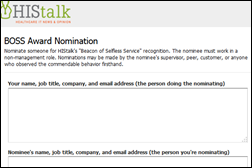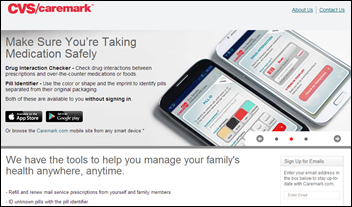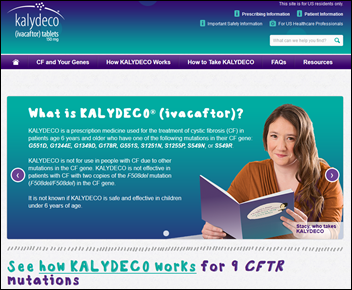The CEO sentenced to jail for massive healthcare fraud will get pardoned in a week.
News 7/18/14
Top News
CVS Caremark signs a clinical affiliation agreement with four healthcare providers (ProHealth Physicians, Texas Health Resources, Palmetto Health, and The Baton Rouge Clinic) whose patients will gain access to clinical support, chronic disease monitoring, and wellness programs at CVS drugstores and MinuteClinic retail clinics. MinuteClinic will send electronic medical histories and visit summaries to each patient’s PCP and CVS will share messages and alerts. CVS announced in February 2014 that its MinuteClinic division would move from its homegrown EHR to Epic’s EpicCare, saying it needed a platform that would allow it to share information with other providers more quickly and give it patient portal and analytics capabilities.
Reader Comments

From Pop Counter: “Re: EHR vendors counting patients. Epic touts 50 or 60 percent coverage of the US population. How do they arrive at that number and how does it align with market share?” It’s an arguably flawed SWAG that doesn’t have a lot to do with market share, but it is a great marketing point from a company that claims to employ no marketing people, where huge marketing billboards magically appear on its HIMSS booth walls without human intervention. The “percentage of the US population” claim is also being used to impress the Department of Defense in its EHR selection. I’ve heard that Epic simply asks its customers (even the non-live ones) to estimate the number of patients they serve, applies some mysteriously derived percentage of potential overlap with other Epic sites, and then just adds it up. But let’s look at it from the point of view of an EHR company engineer being asked by the marketing department to arrive at such a number. Being objective and pedantically pragmatic as engineers often are, you would point out these challenges:
- We don’t host every client system, so we can’t just run some super-query of unique medical record numbers. We have to ask the hospitals to report the number back to us.
- Even though an individual health system may have successfully applied the one-patient, one-record rule, there’s no easy way to de-dupe overlapping patients across multiple clients without some kind of master person index algorithm. As a vendor with multiple health system clients in the same geographic area, we can’t easily account for patients who have information in all of them.
- We would be counting imported CCD record from someone else’s system. Should we really count that as a complete patient record in our system when it wasn’t even created there?
- We have a massive number of old patient demographics that we imported from our legacy system during conversion and we haven’t seen some of those people for 10 or more years.
- Some patients in our database have died, quite likely elsewhere so that we don’t have a record of it.
- Since we have an ambulatory system, we get an easy “credit” for a patient who merely drops by for a one-time ophthalmology consultation or lab test with no plans to return. The “record” in our system is minimal, containing (if we’re lucky) allergies, chronic conditions, and medication reconciliation. Almost everything of value is stored by other providers.
- We as a vendor who sells primarily to large academic medical centers can boast of more patients because of higher churn from referrals, specialty clinics, and large ambulatory practices, all of which see patients who are also in the EHR databases of many other providers. Ambulatory visit patients greatly outnumber hospital inpatients, so the numbers are artificially skewed to favor vendors with many active sites in both, and in fact a large ambulatory EHR vendor may have more unique patients than any hospital vendor.
- It’s not a zero-sum game. The market-leading system might claim 50 percent of US patients, the runner-up could have 45 percent, the third-place vendor might count 40 percent, and so on. That doesn’t mean we’ve sold more systems, have more users, process more active patients, or house complete data on more patients than anyone else.
- As an engineer, I think we need to be careful about implying that having a high percentage of the population covered reflects attributes of our system or our company that are important to prospects. It’s more accurately a reflection on the size and patient diversity of our existing customers.

From The PACS Designer: “Re: BlackBerry. It’s not seen much in the healthcare setting, but that could change if it becomes a takeover candidate. With its shares selling below $10, BlackBerry might soon become a division of Apple since consolidation in the mobile space is starting to happen. The real question is would that be practical for Apple to pursue.” BlackBerry’s market capitalization is down to around $5 billion after a big drop following the Apple-IBM enterprise announcement, which threatens BlackBerry’s one bright spot of mobile device management revenue. However, the company has $3 billion in cash, an enterprise user base that has no instantly appealing alternative, and a bunch of patents, so someone should be interested.

From Point Taken: “Re: GE Healthcare. Any idea of substantive outcomes from the bold 2012 aspiration from GE, saying that it will invest $3 billion in R&D in the Healthymagination program to foster at least 100 innovations to lower healthcare costs by 2015?” I will leave it to GE to respond if they like. I know they’ve done a lot specifically to develop lower-cost medical technology (not IT) in India, but I haven’t heard otherwise. The few press releases on the Healthymagination site are old, the most recent annual report posted is from 2012, and the newest video on their YouTube channel is from 2012.
From Sext Machine: “Re: doctor sexting during surgery. Thanks for the post – we got a kick out of that at our company. Do you know of other physicians who have gotten in trouble for using SMS messaging to share patient data?” I will defer to readers since the “trouble” involved is likely to be more related to internal discipline rather than being formally charged with violating HIPAA. I will say that I talked to a CIO today who implemented a secure messaging system to avoid users sending PHI via text messaging, but then found additional benefit in using the system to coordinate care among physicians.
From CEO: “Re: social media. We’ve been writing a weekly company blog but haven’t gotten Twitter and LinkedIn followers. How can we get better social media visibility?” I should mention that this was an actual (paraphrased) question I received today from the CEO of an HIStalk sponsor. Here was my excerpted answer, which I figured I might as well share in case anyone else is interested:
Company blogs rarely say anything fresh or insightful, often being cranked out by a marketing person or ghostwriter. They also try to appeal to every kind of reader, from newbie to old pro, programmer to CEO, with content that nobody hates but that nobody loves either. As a result, they aren’t going to get a lot of social media attention because they don’t say anything new. I don’t think your tweets will be all that compelling to Twitter users since they are infrequent, mostly link back to company material on your website, and don’t have much personality. People with big Twitter followings tend to be passionate about a subject other than their employer and that enthusiasm shines through. However, the question is whether that even matters. Companies tend to get wrapped up in the number of followers or retweets without having any idea whether that translates into more business.
HIStalk Announcements and Requests

Reminder: you can nominate a non-management employee, co-worker, or vendor person for the HIStalk BOSS (Beacon Of Selfless Service) award. It’s for people who went above and beyond during a specific incident, such as downtime, an IT crisis, bug fix all-nighter, or anything else in which your nominee sacrificed their own self-interest to fix a problem.


We like Niko Skievaski, the former Epic guy who produced “Struck by Orca,” an entertaining book about ICD-10 (he dropped off autographed copies at our HIMSS14 booth). He’s working on a new book, MU2i (MU2 Illustrated), which will ship in September. Artistic types who are willing to contribute a picture can contact Niko.
This week on HIStalk Practice: Mostashari’s Aledade venture works to set up an ACO in Arkansas. Healthcare IT sees its first billion-dollar acquisition quarter. CVS announces new clinical affiliations and a $1.5 million community health center grant program in partnership with IBM. A new independent practice study finds EHR workarounds are used for three main problems. Takeaways from the recent eHI webinar on ONC’s 10-year vision for interoperability. Providers and consultants are welcome to share an “Idea of the Day” with the HIStalk Practice audience. Thanks for reading.
This week on HIStalk Connect: Dr. Travis covers the growth of ZocDoc, benchmarking its success against his early predictions for the company. Google announces that it will commercialize its glucose monitoring contact lenses through a partnership with medical device manufacturer Novartis, which hopes to have the non-invasive glucose reading lenses on shelves within five years. Apple teams up with IBM to target the enterprise mobile markets.
Listening: new from the 60-something metal gods Judas Priest, who sound great even with the album’s horrible production. Also: new Linkin Park.
Acquisitions, Funding, Business, and Stock

Athenahealth announces Q2 results: revenue up 27 percent, adjusted EPS $0.32 vs. –$0.08, beating expectations for both.

Microsoft announces that it will cut 18,000 jobs in the next year – 14 percent of its workforce – with the former Nokia unit taking most of the hit. Like all companies desperately ditching headcount to keep Wall Street happy, the Bill-less and Balmer-less Microsoft says it will simplify processes, increase accountability, reduce management layers, and make itself faster and more agile. I don’t recall hearing the announcements when it made processes more complicated, reduced accountability, added management layers, and let itself get slower and fatter. Microsoft paid $7.2 billion for Nokia in September 2013, which was probably the polite thing to do given that Nokia’s demise was hastened by hitching its teetering wagon to Windows Phone.
Behavioral EHR vendor Valant Medical Solutions receives an $11 million private equity investment.
Medical image exchange platform vendor DICOM Grid gets $6 million in funding from Mayo Clinic and Canaan Partners.
Online doctor search vendor BetterDoctor closes $10 million in Series A funding.
Sales
Texas Health Resources (TX) chooses LogicStream Health’s Intelligence Platform to manage and optimize its clinical decision support. I’ve pored over the company’s site for several minutes and I still can’t figure out how its product works given the maddeningly high-level non-detail it provides in abundance.
Desert Imaging (TX) chooses IDS AbbaDox RAD to manage its radiology workflow.

Children’s Hospital Los Angeles (CA) and Wisconsin Statewide Health Information Network sign four-year contracts for Orion Health’s Rhapsody integration engine.
The FHP Health Center (Guam) selects the eClinicalWorks EHR.

University of Kansas Hospital selects Health Catalyst’s data warehouse.
People

Susannah Fox (Pew Research Center) is named as an entrepreneur in residence at the Robert Wood Johnson Foundation.

Informaticist and former ONC Deputy National Coordinator Charles Friedman, PhD is promoted to chair of the Department of Learning Health Sciences at the University of Michigan Medical School.

Paient satisfaction and physician reputation vendor SayAh names Warren Dodge (Creekside Healthcare Consultants, Altos Solutions) as CEO.
Announcements and Implementations
TeraMedica completes the implementation of its Evercore VNA for the public health system of New South Wales, Australia, saying it’s one of the world’s largest VNAs in covering 7 million patients, 110 facilities, and nine PACS that process 3 million imaging procedures each year.

The Central Texas division of Baylor Scott & White Health goes live on API Healthcare’s ShiftSelect.
Government and Politics
Two subcommittees of the House Energy & Commerce Committee held a joint meeting Thursday to discuss the use of technology to advance medicine. Above is Rep. Phil Gingrey, MD (R-GA) calling out Epic for selling a “closed platform” whose users have received more than half of the $24 billion in HITECH payouts, asking if taxpayers should be subsidizing the purchase of products that are supposed to be interoperable but aren’t. Gingrey says it may be time for the committee to look at the practices of EHR vendors, saying “fraud may be perpetrated on the American taxpayer.”
Three Arkansas Medicaid patients sue the state for refusing to pay for a cystic fibrosis drug that costs $300,000 per year. The patients meet FDA’s treatment criteria, but the state says the patients must first prove that older and cheaper drugs don’t work for them. According to the executive director of the National Association of Medicaid Directors, “We have this public health mentality that all people have to be cured no matter what the cost, and also let the innovators charge whatever they want. Those are fine theories independently, but when you combine them together in a finite budget environment, it’s not sustainable.”
In Canada, Telus Health opens an innovation center in Toronto.
A physician reviews a $3.99 iPhone app that claims to measure blood pressure using only the iPhone, with the developer suggesting it’s a Johns Hopkins product. The physician reviewer talked to the CEO (who graduated from Hopkins but is otherwise unaffiliated) who says the app is “for entertainment purposes only” and shouldn’t actually be used to measure blood pressure. He says he’ll consider adding that disclaimer, which should not exactly boost sales.
Other

Medscape surveys 18,000 self-selected physicians about their EHRs. My observations:
- The survey asked, “Are you using an EHR?” which is a horrible question given that (a) it doesn’t distinguish between a practice EHR and a hospital EHR and most physicians practice in both settings, and (b) it doesn’t define “using.” All but 7 percent of respondents said they’re using an EHR or planning to do so within two years.
- The most widely used EHRs (again subject to the limitations of failing to distinguish between practice vs. hospital) are Epic (23 percent), followed by Cerner, Allscripts, eClinicalWorks, and NextGen. Three percent or fewer reported using well-known systems such as Practice Fusion, the VA’s VistA, athenahealth, Greenway, and McKesson.
- The top-rated system was the VA’s VistA, which also had the highest reported user satisfaction. However, the VA’s physician users are all employed and use only that EHR, so they’re probably going to be happier than a community-based doctor who has an EHR in the office plus different EHRs at each hospital in which he or she sees patients.
- VistA and Epic were top rated for connectivity.
- Only 42 percent of respondents said they are satisfied with their EHR vendor, and 16 percent say they’ll be replacing their system (it’s not clear how the hospital-based doctors could have answered this since it’s not their call).
- Overall, the survey’s results are questionable in its failure to distinguish among the multiple settings in which the average physician uses EHRs and its lack of definition of “using” (Entering orders? Having a clerk create a bill? Looking at a hospital rounds list on an iPhone?) For that reason, I would characterize its conclusions as entertaining but hardly authoritative. However, I doubt that will stop vendors and lazy writers from crafting clickbait headlines and swaggeringly wordsmithed stories about the results.

In the UK, Homerton University Hospital NHS Foundation Trust goes live with RFID technology that will track the movement and location of paper charts within the facility. The hospital says it won’t even bother to file patient notes alphabetically since they can just be shelved and located later by RFID. Paper records were tracked previously using Cerner Millennium.
An article in Health and Human Rights Journal profiles New York City’s jail system, which tweaked its eClinicalWorks EHR to help protect the rights of high-risk inmates (the article fails to note the difference between jails and prisons, the former being local facilities housing both those awaiting trial as well as those serving short sentences, so calling their occupants “prisoners” isn’t correct). EHR templates were created to identify injury patterns in vulnerable populations (LGBT, mental illness, injured, held in solitary confinement) consistent with inmate wrongdoing, officer misconduct, sexual assault, and self-harm.


Weird News Andy simply titles this story as “Smile.” Police arrest an upstate New York man for flying a $1,300 video-recording drone in front of the windows of a medical facility’s exam rooms. “Front Row Dave” says he made a mistake but won’t stop “droning.” His Facebook page has a picture of his drone, which appears to be a DJI Phantom 2 Vision+ Quadcopter with FPV HD Video Camera and 3-Axis Gimbal. The video above was made by a guy on a cruise using that same drone, which must be a voyeur’s delight. I’m thinking about flying one over HIMSS conference airspace in Chicago, or perhaps in the exhibit hall.
Sponsor Updates
- Orchestrate Healthcare posts a blog entry, “Healthcare Business Intelligence: Harness the Power.”
- PerfectServe’s VP/Chief Clinical Officer Leigh Ann Myers, RN writes a blog post, “Changing the Culture for SBAR Communications.”
- Kareo opens an operations center in Las Vegas, NV.
- Regenstrief Institute joins ConvergeHEALTH by Deloitte’s real-world evidence and analytics consortium.
- AirWatch by VMware opens registration and lineup of analyst speakers for the Airwatch Connect Global Tour 2014 in Atlanta, London, and Sydney.
- McKesson launches Benchmark Analytics, which provides reports and consulting services to optimize performance.
- GetWellNetwork’s CEO Michael O’Neil discusses the CDC Morbidity and Mortality report on the cost of cancer survivorship with a local journal.
- Kareo and Falcon EHR partner to provide cloud solutions to nephrology practices.
EPtalk by Dr. Jayne

HIMSS15 is looking for proposals for preconference symposia. We’re returning to Chicago this year, so dig out your winter boots and scarves. I’m not convinced that moving to April is going to allow the meeting to escape winter’s wrath. I seem to be cursed any time my travel remotely involves Chicago, so I’m not sure I’m looking forward to it.
Continuing the Open Payments saga from earlier this week, I was finally confirmed as a real, live physician so that I could access my data. I don’t have any data listed for the 2013 program year and that’s probably accurate, plus or minus a martini. I know I provided my NPI to one device manufacturer when we had drinks, but the reporting threshold is $10 and I’m not sure I topped that even though the cocktail in question was good.
Speaking of money, AMDIS released its annual report on CMIO salaries. There were 120 respondents and average compensation was up, according to the report. Based on the compensation of CMIOs I know well, the range isn’t terribly reflective of our reality in the trenches. The report also noted that although salaries have increased, job satisfaction is on the decline. I would agree that job satisfaction is an issue. It could be that my role has matured or perhaps it’s all the government regulations, but the job isn’t as much fun as it used to be. I’m the kind of CMIO that enjoys rolling up my sleeves and digging into cool projects, so every time I have to sit on another committee or address another regulation, it sucks a little bit of my life away.
I was surprised to see that more than 70 percent of respondents maintain a clinical practice. It’s getting harder and harder to do so. I’m one of the CMIOs whose own organization doesn’t support administrators who want to continue seeing patients. My clinical opportunities are cobbled together at a variety of facilities, which makes scheduling a bit of a challenge.
It’s hard to interpret the data with the relatively small sample size, however. I’m not sure how many CMIOs there are in the US, but there are many more people doing CMIO-type roles without the title and often without the compensation. Of respondents, 25 percent are certified in the subspecialty with another 25 percent considering it. Unfortunately many of my strongest colleagues are unable to sit for the exam since they didn’t maintain a primary board certification. I’m somewhat ambivalent about that personally and hope that those physicians who are certified but don’t see patients any more aren’t required to keep up a primary certification for no reason.
On the other hand, I had an email this week from a recruiter looking for a board certified physician to fill a locum tenens job in the US Virgin Islands, so maybe that primary certification is a good thing after all. They actually said “soaking in the sun with beverage in hand” in the opening paragraph, so they get full credit for that one. Doubtful that the actual experience would live up to the hype, like so much in healthcare these days.
I love some of the headlines I see: recently “MU drives patient savings” has been my favorite. Based on the duration of the program and what was actually involved in Stage 1, coupled with the relatively small numbers of providers attesting for Stage 2, I’m not sure we can arrive at this conclusion. Did they factor in the time cost of visits running late because providers were playing catch-up with the ever-increasing and burdensome requirements? Interestingly, the study in question had data provided by HIMSS.
Another great one cited Stage 2 EHRs as not being ready for data sharing. I don’t disagree with this one, although I think they focused too much on the technical problems of CCDA exchange and not enough on the philosophical problems. Some of the documents I see coming into our system are technically correct, but really don’t tell the clinician what he or she needs to know. For example, a patient who was seen in the emergency department for a laceration. I’d rather have the physician’s pen-and-ink sketch of the wound than any syntactically correct description, but there’s no room for that in the game of data exchange.
It’s probably a good thing that I can’t keep up with all the news that hits my inbox because it would just aggravate me. If I’m going to be aggravated, I’d rather be annoyed by the challenges of my latest pastry therapy project. For those playing along at home, this week’s specimen is the Blueberry-Lemon Bundt Cake from my good friend Martha Stewart. And thanks to YouTube for videos on how to zest a lemon without going insane. The picture doesn’t do it justice, but I loved the cake pan.
Got a favorite Bundt cake pan or recipe? Email me.
Contacts
Mr. H, Lorre, Jennifer, Dr. Jayne, Dr. Gregg, Lt. Dan, Dr. Travis.
More news: HIStalk Practice, HIStalk Connect.
Get HIStalk updates.
Contact us online.











RE: SayAh. According to their Website: “Today it is estimated that 80 percent of perspective patients go online to research a physician’s background and reputation prior to making an appointment. And, over 70 percent of perspective patients feel that a doctor’s reputation is the most important criteria they consider before deciding whether or not to make an appointment.”
What is a perspective patient? Is this some new business jargon about the patient who builds a physician reputation? Looks more like a spelling issue by a reputation company.
Epic number is pure marketing spin and they should get called out on it because their number relies upon self-reported metrics which almost certainly has a large amount of multiple counting & over exaggerated market share/impact as a result.
Easily could use a commonly-accepted method that measures their provider market share for hospitals (eg, % of staffed beds; % of discharges, etc) or physicians (eg., % of physician offices, % of physicians, etc).
HIMSS in Chicago… does anyone else feel that it is somewhat self serving to have it there any time of year?
Re: Drones at HIMSS. Isn’t there already enough droning at HIMSS? Actually, I bet HIMSS attorneys are updating exhibitor contract to address drones. Otherwise, imagine all the fun possibilities – just off the top of my head:
1. Fly a drone with your messaging (video? drop small promotional paraphernalia?) over your competitor’s booth entrance.
2. Equip a response drone to take down your competitor’s drone hovering at your booth entrance (electromagnetic pulse? greased aluminum fragment cloud sprayer to gunk up audio stream / propellers?)
3. Create a drone insurance offering to cover exhibitors injuring attendees (and each other) with all the drone mishaps bound to occur.
4. For the M&A crowd, perform overhead traffic monitoring / heatmapping….
5. Employ a small speaker so you can deliver remote one-liners about “droning” salespeople.
6. Hire a team of drone acrobatic flyers to draw traffic to your booth.
7. Figure out how to tie in “drone” and “DrOne” (medical drone for physicians?)
@Lazio Hollyfeld, the numbers Epic quotes are based on the amount of patients that would be covered once their software is fully rolled out across their customer base. That includes groups, like Partners and CHI, that cover a good amount of patients, but aren’t anywhere close to being fully extended on the software. They do try to run the numbers through an EMPI, eliminate duplicates, and then apply some statistical analysis to come up with a range. I never saw a hard number, it was typically a 10% range of the amount of patients they cover in the US. Regardless, they have a dominant market share in their target market.
It’s also interesting to see that the congressman from Massachusetts is clearly a puppet for Jonathan Bush and Athena. If they are going to be that thinly-veiled, just put Jonathan up to the mic.
I like my Nokia Lumia 929 Windows Phone. A lot …
Epic’s install base is 20-25% of their respective markets (physician offices and hospital facilities) in the US right now and even if you include their future installs it is nowhere near 50-60% of either market.
Thanks for clarifying and how Epic derives the count with their EMPI. Just because a patient at some point went to a physician’s office or hospital running Epic doesn’t mean that translates into a more clear definition of market share that traditional US anti-trust agencies (FTC/DOJ) would use to examine the competitiveness of a market place or that the provider organization or an external firm would attribute that patient to the organization running Epic.
You really can’t have a discussion about “how much market share?” without defining the market. The second you include physician offices there is a big difference from a 700 provider network running Epic and a single provider running something else. The reality is that Epic has a very large percentage of the larger provider networks and large hospital facilities. If you defined the market as provider networks over 200 providers and hospital systems over 5 hospitals, Epic would have a very high >40% market share. If you were to include individual physician offices and count them on equal footing as a provider network you might be able to drop that percentage to 20%. Let’s assume company A sold to 10 physicians practicing out of their own offices vs company B that sold to 10 provider networks with 200+ providers. Saying that company A and company B have the same market share doesn’t really make sense. At the end of the day, market share doesn’t matter as much as reputation. Epic has a good reputation.